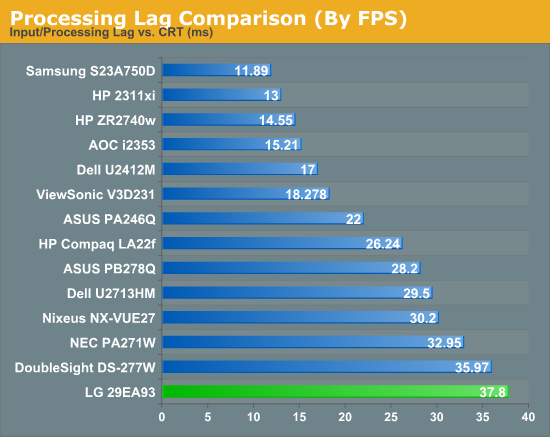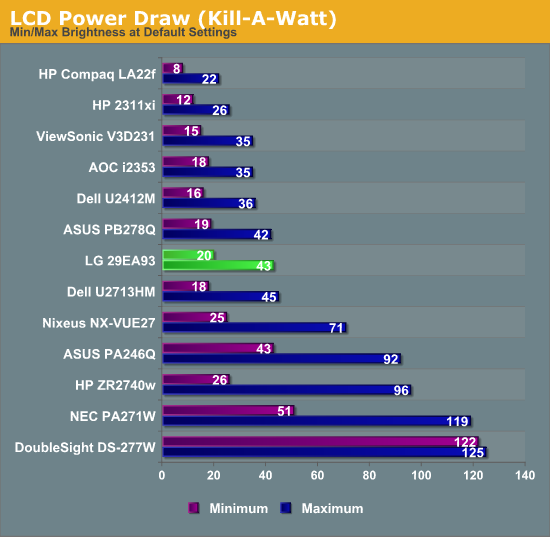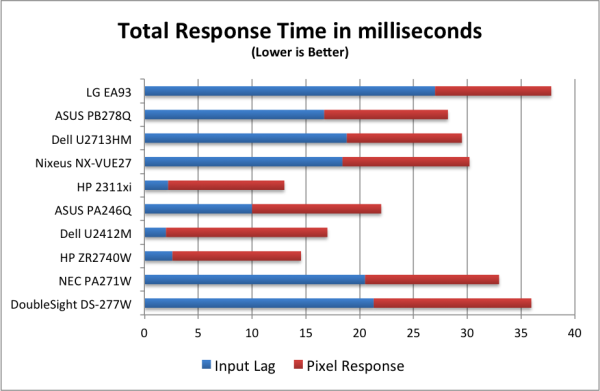LG 29EA93 Ultrawide Display - Rev. 1.09
by Chris Heinonen on December 11, 2012 1:20 AM ESTLG 29EA93—Input Lag and Power Use
Of course there aren’t any 21:9 CRT displays around that I’m aware of so once again this is tested at 1920x1080 resolution using SMTT and the 1:1 mapping selected in the menu. While still not ideal, this is likely very close to how many people will use the LA 29EA93 as game consoles use this resolution, and some PC games might not support 21:9 and be stuck at 16:9 resolutions as well.

As you can see, the lag time is pretty slow on the LG 29EA93. Input lag overall is 27ms, which is the slowest I have recorded from any display at this point. Pixel response time is very normal at 10.8ms, but combined this is generating close to 39ms of lag, well over two full frames in gaming. In my very casual use this didn’t bother me, but I’m certain this is going to turn off those that want to use this as an Eyefinity alternative for first person shooters and other quick response gaming. Using the fast response modes just adjusts the amount of motion blur that was visible but does nothing to help the actual response time of the display.
Power use for the 29EA93 is right in line with a 27” display using LED backlighting. With the backlighting system at maximum and a full white screen, the 29EA93 consumes 43 watts of power, and reducing the backlight to minimum drops power consumption to 20 watts.












90 Comments
View All Comments
Reflex - Tuesday, December 11, 2012 - link
Seriously, that was one of the worst movies I've seen in a while. Ryan Gosling can't act his way out of a wet paper bag, and the plot was nonsensically ridiculous with some truly idiotic characters.I like artsy movies but I did not get the acclaim that movie recieved.
TegiriNenashi - Tuesday, December 11, 2012 - link
Why blackbars on 16:9 screen? Just crop that ridiculous 21:9 to 16:9, which is more than enough wide already. Oh, you are afraid to loose some very important action happening on the sides?It is Hollywood, not display industry, that is desperately behind the times clinging to that ancient 2.37,2.40,2:35 (they can't even make their mind themselves for the exact figure). Lately, there is some sanity coming back, and many blockbuster movies shot in 16:9 OAR. They have to: to achieve maximum 3D effect it's better to fill in the entire field of view, and this is not possible with embrasure view. To summarize, we'll see slow and agonizing death of 21:9 in next 5 years.
cheinonen - Tuesday, December 11, 2012 - link
The ratio for CinemaScope has changed over time, for a number of reasons, but it's not a random number:2.55:1 - Original size with magnetic stripe for audio
2.35:1 - Switch to analog optical audio track that takes up space on film
2.39:1 - Switch in 1970 to smaller gate size to hid splices in the negative
2.40:1 is what many 2.39:1 films are cropped to for home video releases (a difference of 3 pixels vertically). 2.37:1 is what 21:9 monitors wind up being as they use common sizes from other displays (1080 pixels high, 2560 wide like 27" and 30" displays).
Cinemascope ratios aren't close to dying, and will be around just as much in 10 years as they are now as they still offer something that most people can't get at home.
TegiriNenashi - Tuesday, December 11, 2012 - link
I must give LG a credit: take some defective 30" 2560x1600 panels, cut top and bottom and resell it as "new" "innovative" product...The industry moves in bizarre ways. Take that crippled 21:9 58" Vizio. It is passive 3D, so it's half of the resolution vertically. That's right, they have 540 vertical pixels, and 5(!) times more pixels horizontally.
ReaM - Monday, January 21, 2013 - link
No movie will ever be shot in 16:9, because 16:9 is aesthetically bad. It looks bad. It does not have that "magic" movie feel, which is basically 24 frames per second and 2.39:1.I for example don't watch cropped movies. It is for aesthetical reason that they use a format that wide. The frame looks different, there is more story told in each frame and there is a lot of useless detail missing that otherwise would be there (like a lamp overhead). You can do a lot more in 2.39:1 than in 16:9.
radbeard - Tuesday, December 11, 2012 - link
I recently started using a 29'' 21:9 display from the Dell Ultrasharp series. Some of my experience differs for this reason (minimal light bleeding and a stand that does allow the screen to move vertically), but it is largely a similar experience to this LG display.This monitor, and aspect ratio, are near-perfect for a specific set of functions and entirely wrong for most mainstream home usage.
For movie watching, you are probably better off with a cheap and large 1080p 27'' panel. Most content is this, or nearly this, aspect ratio and the screens are less expensive.
For games a true 2560x1440 monitor offers a larger display area, and is preferable.
For web browsing a 21:9 monitor gives you an enormous quantity of dead space, and the same experience as a 23'' 1080p monitor.
Where the 21:9 shines, and is quickly becoming indispensable for me is at-work productivity. As someone that is always working with 2-4 different files (pdfs, excel, email) I need to be able to see items side by side. Looking at a financial report and then updating the bits relevant, this is the perfect set of compromises.
16:9 is NOT a work-friendly format. I do not need to see all those additional rows in excel normally (although 21:9 allows for more of that vision if necessary), I also don't need the extra width on PDFs (which are scanned from typical A4 letters), or emails, which scale.
What I really need are 4:3 monitors, but a couple of then. The 21:9 format is very practically 2 of these monitors combined in one. You take different documents and give them each half a screen.
It is for this use that the review should be directed. I strongly encourage offices that use multi-screen setups, or ask their employees to work with multiple pieces of data at once to consider these as replacements.
Kevin G - Tuesday, December 11, 2012 - link
Have you been able to test the DisplayPort chaining this with that Dell? First monitor I've seen commonly available to have that feature.radbeard - Tuesday, December 11, 2012 - link
afraid not. I have this at my desk at work.CharonPDX - Tuesday, December 11, 2012 - link
Yes, I could do math, but I'm busy at work and too lazy to figure it out:How does this compare in vertical size to a 27" 16:9 display? Is it the same height, only wider? Or is it shorter in height?
Did you compare input lag on different interfaces? DP vs. HDMI vs. DVI? It's possible that one input is "native" and the others go through conversion internally, adding lag that wouldn't be present on a different input.
radbeard - Tuesday, December 11, 2012 - link
i have the dell version. its about the same height as a 23'' 16:9 display but wider.Its awesome for productivity, not media.